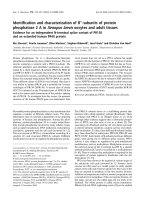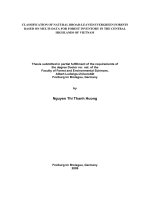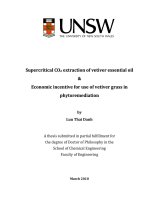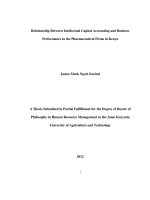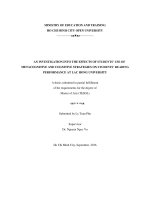an independent thesis submitted in fulfillment of the requirements for the degree of doctor of philosophy
Bạn đang xem bản rút gọn của tài liệu. Xem và tải ngay bản đầy đủ của tài liệu tại đây (909.87 KB, 354 trang )
Jointness of Loan Contract Terms, Information
Asymmetries, and Lending Relationships
Pham Phu Quoc
BEcon (Banking) – Banking University of Ho Chi Minh City, Vietnam
MA (Economics) – University of Colombo, Sri Lanka
An independent thesis submitted in fulfilment of the requirements for the
degree of Doctor of Philosophy
Department of Accounting and Finance
Faculty of Business and Economics
Monash University
November 2012
TABLE OF CONTENTS
TABLE OF CONTENTS
LIST OF TABLES
ABBREVIATIONS
ABSTRACT
STATEMENT OF AUTHORSHIP
ACKNOWLEDGEMENTS
CHAPTER 1 - INTRODUCTION
1.1 INTRODUCTION
1.2 BACKGROUND
1.2.1 Information Asymmetries
1.2.2 Lending Process
1.2.3 Loan Contract Terms
1.2.4 Borrower Information and Lending Relationships
1.3 MOTIVATIONS AND RESEARCH QUESTIONS
1.3.1 Jointness of Loan Contract Terms
1.3.2 Information Asymmetries and Loan Contract Terms
1.3.3 Lending Relationships and Loan Contract Terms
1.4 RESEARCH OBJECTIVES AND HYPOTHESES
1.5 DATA, METHODOLOGY, AND EMPIRICAL FINDINGS
1.5.1 Data
1.5.2 Methodology
1.5.3 Empirical Findings
1.6 CONTRIBUTIONS
1.7 IMPLICATIONS
1.8 STRUCTURE OF THE THESIS
CHAPTER 2 - LITERATURE REVIEW
2.1 INTRODUCTION
2.2 THEORY AND EVIDENCE ON LOAN TERM RELATIONS
2.2.1 Relations between Loan Contract Terms
2.2.2 Jointness of Loan Contract Terms (Hypotheses for RQ1)
2.3 INFORMATION ASYMMETRIES AND CONTRACT TERMS
2.3.1 Information Asymmetries and Loan Terms
2.3.2 Loan Term Trade-Offs and Information Asymmetries
2.3.2.1 Loan Size Selection, Given Loan Term Jointness
2.3.2.2 Covenant Choice, Given Loan Term Jointness
2.3.2.3 Loan Price, Collateral, and Maturity Choice, Given Loan
Term Jointness
2.3.2.4 Hypotheses for RQ2
2.4 LENDING RELATIONSHIPS AND LOAN TERMS
2.4.1 Lending Relationship Concepts
3.4.1.1 Lending Relationships
ii
ii
vi
viii
ix
xii
xiii
1
1
2
2
3
4
4
5
5
8
9
11
15
15
16
17
20
22
24
25
25
25
25
33
36
36
39
39
42
43
43
45
45
45
3.4.1.2 Lending Relationship Measures
Literature on Lending Relationships and Loan Terms
Hypotheses for RQ3
2.4.3.1 Impact of Lending Relationships on Loan Covenants
2.4.3.2 Impact of Lending Relationships on Loan Size
2.4.4 Hypotheses for RQ4
2.5 CHAPTER SUMMARY
CHAPTER 3 - DATA AND METHODOLOGY
3.1 INTRODUCTION
3.2 DATA AND SAMPLE
3.2.1 Data Sources
3.2.2 Database Characteristics
3.2.2.1 DealScan’s Information Sources
3.2.2.2 DealScan’s Deal and Facility Classifications
3.2.2.3 Searching DealScan Borrower Information from
Compustat
3.2.2.4 Reporting Year Inconsistencies between DealScan and
Compustat
3.2.2.5 Potential Misidentification of Lender and Borrower
Names
3.2.3 Revolving and Term Loans
3.2.4 Sample Units, Sampling Procedures, and Composition
3.3 METHODOLOGY FOR RQ1, RQ2, AND RQ3
3.3.1 Model Specification
3.3.2 Estimation Methods
3.4 METHODOLOGY FOR RQ4
3.4.1 Model Specification
3.4.2 Estimation Methods
3.5 ROBUSTNESS TESTS
3.5.1 Different Proxies for Information Asymmetries
3.5.2 Alternative Measures of Lending Relationship
3.5.3 Endogeneity of Loan Type Selection
3.6 CHAPTER SUMMARY
CHAPTER 4 - VARIABLES AND DESCRIPTIVE STATISTICS
4.1 INTRODUCTION
4.2 VARIABLES
4.2.1 Loan Contract Terms
4.2.1.1 Loan Price
4.2.1.2 Collateral
4.2.1.3 Maturity
4.2.1.4 Covenants
4.2.1.5 Loan Size
4.2.1.6 Other Loan Characteristics
4.2.2 Lender Characteristics
4.2.3 Borrower Characteristics
2.4.2
2.4.3
iii
46
47
52
53
54
55
57
60
60
60
60
62
62
62
63
64
65
66
68
71
72
75
82
82
83
85
85
85
86
90
92
92
92
92
93
93
95
95
98
99
101
102
4.2.3.1 Information Asymmetries
4.2.3.2 Lending Relationships
4.2.3.3 Other Borrower Characteristics
4.2.4 Macroeconomic Factors
4.3 DESCRIPTIVE STATISTICS AND CORRELATION ANALYSIS
4.3.1 Descriptive Statistics
4.3.2 Correlation Analysis
4.4 CHAPTER SUMMARY
CHAPTER 5 - EMPIRICAL RESULTS
5.1 INTRODUCTION
5.2 EMPIRICAL RESULTS FOR RQ1
5.2.1 Results for H1.1
5.2.2 Results for H1.2 and H1.3
5.2.3 Summary of Hypothesis Testing for RQ1
5.3 EMPIRICAL RESULTS FOR RQ2
5.3.1 Results for H2.1
5.3.2 Results for H2.2
5.3.3 Results for H2.3
5.3.4 Results for H2.4
5.3.5 Results for H2.5
5.3.6 Summary of Hypothesis Testing for RQ2
5.4 EMPIRICAL RESULTS FOR RQ3
5.4.1 Results for H3.1
5.4.2 Results for H3.2
5.4.3 Summary of Hypothesis Testing for RQ3
5.5 EMPIRICAL RESULTS FOR RQ4
5.5.1 Results for H4.1
5.5.2 Results for H4.2
5.5.3 Results for H4.3
5.5.4 Results for H4.4
5.5.5 Summary of Hypothesis Testing for RQ4
5.6 RESULTS FOR CONTROL VARIABLES AND ROBUSTNESS TESTS
5.6.1 Results for Control Variables
5.6.2 Robustness Tests of the Hypotheses for RQ1, RQ2, RQ3, and RQ4
5.6.2.1 Other Information Asymmetry Proxies
5.6.2.2 Alternative Lending Relationship Measures
5.6.2.3 Endogeneity of Loan Type Selection
5.7 CHAPTER SUMMARY
CHAPTER 6 - CONCLUSION
6.1 INTRODUCTION
6.2 REVIEW OF RESEARCH QUESTIONS, HYPOTHESES, AND
FINDINGS
6.2.1 RQ1: Are loan contract terms (i.e., price, collateral, maturity,
covenants, and size) simultaneously determined?
6.2.2 RQ2: Given their jointness, are loan terms (i.e., price, collateral,
iv
102
106
109
116
122
122
128
129
130
130
130
131
133
142
144
145
146
146
147
148
149
151
152
152
153
154
157
158
158
159
159
161
162
162
162
163
163
164
166
166
166
168
170
maturity, covenants, and size) traded off when addressing borrower
information asymmetries?
6.2.3 RQ3: Given the jointness of loan terms, do lending relationships
affect loan covenants and size?
6.2.4 RQ4: Given the jointness of loan terms, do borrowers with higher
information asymmetries benefit from better price and non-price
terms from their relationship lenders?
6.3 CONTRIBUTIONS
6.4 IMPLICATIONS
6.5 LIMITATIONS
6.6 FUTURE RESEARCH DIRECTIONS
REFERENCES
APPENDIX A - SELECTED LOAN DATA CHARACTERISTICS
APPENDIX B - EXPECTED SIGNS OF VARIABLES
APPENDIX C - CORRELATION MATRIX FOR REVOLVING AND TERM
LOANS
APPENDIX D - FIRST STAGE REGRESSION FOR THE RQ1, RQ2, AND
RQ3 MODEL
APPENDIX E - FURTHER ANALYSIS ON THE RQ1, RQ2, AND RQ3
MODEL
E.1 MULTICOLLINEARITY DETECTION
E.2 LOAN TERM RELATIONS
E.3 LENDING RELATIONSHIP IMPACT ON LOAN TERMS
E.4 RESULTS OF CONTROL VARIABLES
APPENDIX F - ROBUSTNESS TESTS FOR RQ1, RQ2, AND RQ3
F.1 DIFFERENT PROXIES FOR INFORMATION ASYMMETRIES
F.2 ALTERNATIVE MEASURES OF LENDING RELATIONSHIPS
F.3 ENDOGENEITY OF LOAN TYPE SELECTION
APPENDIX G - DETAIL ESTIMATES RELATED TO THE RQ4 MODEL
APPENDIX H - ROBUSTNESS TESTS FOR RQ4
H.1 DIFFERENT PROXIES FOR INFORMATION ASYMMETRIES
H.2 ALTERNATIVE MEASURES OF LENDING RELATIONSHIPS
H.3 ENDOGENEITY OF LOAN TYPE SELECTION
v
171
172
173
177
179
181
184
218
224
226
234
238
238
242
245
247
250
250
267
288
294
298
298
315
336
LIST OF TABLES
Table 1.1
Table 2.1
Table 2.2
Table 2.3
Table 2.4
Table 2.5
Table 3.1
Table 3.2
Table 3.3
Table 3.4
Table 3.5
Table 4.1
Table 4.2
Table 4.3
Table 5.1
Table 5.2
Table 5.3
Table 5.4
Table 5.5
Table 5.6
Table 5.7
Table 6.1
Table A1
Table A2
Table A3
Table A4
Table B1
Table C1
Table D1
Table E1
Table F1
Prior studies on loan term jointness
Relations between the pairs of loan terms
Summary of the effects of information asymmetry on individual loan
terms
Summary of information asymmetry effects on loan terms, given their
jointness
Summary of prior studies on the impact of the lending relationship on
loan terms
Summary of the four research questions and their hypotheses
Summary of data sources
An example of the contract terms of different facilities in a deal
Sample selection process
Testing procedures for the hypotheses associated with RQ1, RQ2, and
RQ3
Testing procedure for the hypotheses associated with RQ4
Financial and general covenants
List of variables and their definitions and data sources
Descriptive statistics and difference test results for revolving and term
loans
DWH statistics for exogeneity tests
Second-stage regression results
Summary of test results for the hypotheses related to RQ1
Summary of test results for the hypotheses related to RQ2
Summary of test results for the hypotheses related to RQ3
Summary of the interaction impacts of information asymmetries and
lending relationship on loan terms
Summary of test results for the hypotheses related to RQ4
Research questions, related hypotheses and results
Distributions of loan types and loan distribution methods from 1987 to
2009
Distribution of loan covenants from 1987 to 2009
Differences between loans with and without collateral information
Comparison of loan terms and firm characteristics in initial and final
samples
Expected signs of variables used in Equations 3.11 – 3.15
Correlation matrix for revolving and term loans
First stage regression for the model related to RQ1, RQ2, and RQ3
VIF values for independent variables in Equations 3.11 – 3.15
Second stage regression results for RQ1, RQ2, and RQ3 with
information asymmetries proxied by LN(FIRMAGE)
vi
7
27
37
39
48
59
61
63
70
80
84
96
118
123
132
135
143
150
153
156
160
167
219
220
221
222
224
226
235
239
251
Table F2
Table F3
Table F4
Table F5
Table F6
Table F7
Table F8
Table F9
Table F10
Table F11
Table G1
Table H1
Table H2
Table H3
Table H4
Table H5
Table H6
Table H7
Table H8
Table H9
Table H10
Second stage regression results for RQ1, RQ2, and RQ3 with
information asymmetries proxied by R&D
Second stage regression results for RQ1, RQ2, and RQ3 with
information asymmetries proxied by FCSTERROR
Second stage regression results for RQ1, RQ2, and RQ3 with
information asymmetries proxied by DISPERSION
Second stage regression results for RQ1, RQ2, and RQ3 with lending
relationships measured by REL(A)
Second stage regression results for RQ1, RQ2, and RQ3 with lending
relationships measured by REL(N)
Second stage regression results for RQ1, RQ2, and RQ3 with lending
relationships measured by REL(D)_3YEAR
Second stage regression results for RQ1, RQ2, and RQ3 with lending
relationships measured by REL(A)_3YEAR
Second stage regression results for RQ1, RQ2, and RQ3 with lending
relationships measured by REL(N)_3YEAR
Logit estimation of revolving loan selection (Equation 3.16)
Second stage regression results for RQ1, RQ2, and RQ3 after
controlling for the endogeneity of loan type selection
Results for interaction impacts of information asymmetries and lending
relationship on loan terms
Second stage regression results for RQ4 with information asymmetries
proxied by LN(FIRMAGE)
Second stage regression results for RQ4 with information asymmetries
proxied by R&D
Second stage regression results for RQ4 with information asymmetries
proxied by FCSTERROR
Second stage regression results for RQ4 with information asymmetries
proxied by DISPERSION
Second stage regression results for RQ4 with lending relationships
measured by REL(A)
Second stage regression results for RQ4 with lending relationships
measured by REL(N)
Second stage regression results for RQ4 with lending relationships
measured by REL(D)_3YEAR
Second stage regression results for RQ4 with lending relationships
measured by REL(A)_3YEAR
Second stage regression results for RQ4 with lending relationships
measured by REL(N)_3YEAR
Second stage regression results for RQ4 after controlling for the
endogeneity of loan type selection
vii
255
259
263
268
272
276
280
284
289
290
294
299
303
307
211
316
320
324
328
332
337
ABBREVIATIONS
2S
CPI
CRSP
DWH
EBITDA
ENSR
FFIEC
GVKEY
H
IA
I/B/E/S
LIBOR
LPC
IPO
LBO
MBO
NIC
NSSBF
OLS
REL
RQ
RSSD ID
SEC
SFE
SIC
SSBF
U.K.
U.S.
VIF
WRDS
Two-Stage
Consumer Price Index
Center for Research in Security Prices
Durbin–Wu–Hausman
Earnings Before Interest, Taxes, Depreciation and Amortization
European Network for SME Research
Federal Financial Institutions Examination Council
Global Company Key
Hypothesis
Information Asymmetries
Institutional Brokers' Estimate System
London Interbank Offered Rate
Loan Pricing Corporation
Initial Public Offering
Leveraged Buyout
Management Buy-out
National Information Center
National Survey of Small Business Finances
Ordinary least squares
Lending Relationship
Research Question
Replication Server System Database Identification
Securities and Exchange Commission
Survey of the Financial Environment
Standard Industrial Classification
Survey of Small Business Finances
The United Kingdom
The United States of America
Variance Inflation Factor
Wharton Research Data Services
viii
ABSTRACT
This thesis shows that five key loan contract terms – price, collateral,
maturity, covenants, and size – are jointly determined and investigates how lenders
and borrowers trade these off to address information asymmetries. It further
examines whether prior lending relationships affect loan covenants and size and
whether borrowers with higher information asymmetries obtain better loan terms
from their relationship lenders. Since revolving and term loans differ in their
characteristics, these issues are examined for the two loan types separately.
The sample consists of 17,636 revolving and 6,625 term loans made by banks
operating in the United States to U.S. non-financial firms from 1 January 1994 to 31
December 2009. A system of five simultaneous equations is used to examine loan
term jointness. It also provides coefficients for an information asymmetry proxy and
a lending relationship measure to examine how loan terms are used to address
information asymmetries as well as whether prior lending relationships impact loan
covenants and size. This model is modified by adding a product of the information
asymmetry and lending relationship measures and then used to investigate if
borrowers with higher information asymmetries obtain better terms from their
relationship lenders.
The empirical results show all five key loan terms are jointly determined. For
revolving loans, high information asymmetry borrowers pay higher prices, are more
likely to be required to provide collateral, and accept shorter maturities in return for
obtaining larger loans with fewer covenants. For term loans, such borrowers pay
higher prices and are more likely to pledge collateral in return for larger loans. Those
ix
borrowers with prior lending relationships accept more covenants but obtain larger
loans for both two loan types. Borrowers with higher information asymmetries,
however, obtain neither lower prices nor more favourable non-price terms from their
relationship lenders.
This thesis makes several academic contributions. It extends other studies
(e.g., Dennis, Nandy, and Sharpe, 2000) to include covenants and loan size as key
loan contract terms and finds that all five loan terms are jointly determined.
Moreover, this study is the first to provide evidence that borrowers and lenders trade
off loan terms when addressing borrower information asymmetries. It is also the first
to show that borrowers accept more covenants but obtain larger amounts from their
relationship lenders. It augments the work of Bharath, Dahiya, Saunders, and
Srinivasan (2011) by examining both price and non-price terms in a simultaneous
equation model across revolving and term loans but finds no evidence that borrowers
with higher information asymmetries obtain better loan terms from their relationship
lenders.
Regarding methodology, this work extends prior studies by using a system of
simultaneous equations to mitigate potential simultaneity problems, considering
differences between revolving and term loans and obtaining different findings across
these loan types. This study reveals the endogeneity of loan selection and addresses
the problem by using the borrower GVKEY and lender RSSD ID in the sampling
selection to trace back prior lending relationships, thus improving the accuracy of the
results.
x
These findings should prove of interest to academics, lenders, borrowers, and
policymakers. Academics should consider the jointness of all key loan terms to
address their endogeneity issues. Revolving and term loans should not be pooled
together in a single sample and the endogeneity of loan type selection (i.e., revolving
and term loans) should be also addressed. Lenders should seek to trade off different
loan terms and address asymmetric information problems to satisfy their borrowers
but be aware that this trade-off differs, depending on loan type. Lenders can also use
more loan covenants and make larger loans to their relationship borrowers due to the
information obtained from their lending relationships. Borrowers with prior lending
relationships have the advantage of be able to obtain larger loans from their
relationship lenders but these loans can entail more covenants. Rather than just
accept less favourable terms, as suggested by prior studies, borrowers with high
information asymmetries may trade them for better ones; however, even lending
relationships will not allow them to obtain better loan terms, except for larger term
loans, from their relationship lenders. Borrowers should also be aware that lenders
can set loan terms differently across revolving and term loans. Policymakers should
avoid risk management regulations focusing only on individual specific terms and
instead encourage banks to consider all loan contract terms.
xi
STATEMENT OF AUTHORSHIP
I hereby declare that this submission is my own work and except where due
reference is made; this thesis contains no material previously published or written by
another person(s).
This thesis does not contain material extracted in whole or in part from a
thesis or report presented for another degree or diploma at Monash University or any
other education institution.
Pham Phu Quoc
November 2012
xii
ACKNOWLEDGEMENTS
First and foremost, I would like to express my gratitude to my main
supervisor, Professor Michael Skully, for his continual guidance, invaluable support,
remarkable patience, useful feedback, and spiritual encouragement. I am also greatly
indebted to my associate supervisor Dr Shrimal Perera for his critical and
constructive comments, continual guidance, and intellectual support to complete this
thesis.
I would like to thank the Ministry of Education and Training of Vietnam for
their generous financial support of my PhD studies. I also wish to thank the
Department of Accounting & Finance of Monash University and Monash University
Institute of Graduate Research for their encouragement and support during my PhD
candidature. Specially, I am particularly thankful to Professor George Tanewski,
Professor Philip Gray, Professor Robyn Moroney, Associate Professor Ly-Fie
Sugianto, and Ms Kim Miller for their help.
My appreciation is also given to Associate Professor Cameron Truong for his
invaluable guidance on SAS coding, to Dr Rasika Amarasiri for his data support, to
Ms Kathy Avram for her useful comments on my PhD proposal, to Professor
Christine Brown for her insightful feedback on my PhD mid-term presentation, to
Professor Kevin Davis (Melbourne University) for his critical comments on my first
conference paper, and to Dr David Tripe (Massey University) for his helpful
comments on my draft chapters. Very special thanks should also go to Mr David
xiii
Horne, Dr Huu Duong, Dr Viet Do, Dr Tram Vu, Dr Binh Do, Dr Kym Brown, and
Dr Zoltan Murgulov for their encouragement and assistance.
I would like to give my sincere thanks to my fellow research students for
their academically useful discussions and research inspirations: Jyotimor Podder,
David T.L. Siu, Intan Abu Bakar, A.S.M. Sohel Azad, Saad Azmat, Philip Bayley,
Vicente De Camargo Bicuido De Castro, Rangika Iddamalgoda, Pearpilai
Jutasompakorn, Nguyen Thi Thuy Linh, Nguyen Thi Yen Ngoc, Ranasinghe
Arachchige Anil Perera, Thangamany Siniah, Singgih Wijayana, Vincent Xiang, Vu
Hoang Van, Nguyen Thi Ngoc My, and Do Xuan Hung.
Professor Michael Ryan Roberts (University of Pennsylvania) also deserves a
special note for his kindness in providing me the GVKEY file which was used in my
data sample collection. The help of Darrenth D. Hawken of DealScan with that
database, Dr Omar M. G. Keshk (Ohio State University) for advice on statistical
packages and Mr David Levy of Mindpro for his editorial comments on my thesis
drafts is also thankfully acknowledged.
Last, but certainly not least, I would like to thank my mother, my sister and
her family members, and specially my wife for their immense, constant and endless
support and encouragements. I also wish to dedicate this thesis to my five-month-old
daughter with whom I will spend more time now that the thesis is submitted.
xiv
CHAPTER 1
INTRODUCTION
1.1. INTRODUCTION
This thesis first investigates the jointness of the key loan contract terms, that
is, price, collateral, maturity, covenants, and size. Given this jointness, it further
examines the impact of information asymmetries and lending relationships as well as
their interaction effects on these loan terms.1 More specifically, it examines whether
these loan terms are simultaneously determined2 and whether they are traded off
when addressing borrower information asymmetries. It also explores whether prior
lending relationships affect loan terms (particularly loan covenants and size) and
whether borrowers with higher information asymmetries can obtain lower prices and
better non-price terms from their relationship lenders. Since revolving and term loan
characteristics differ, these issues are examined separately across these two loan
types.
The remainder of this chapter is structured as follows. Section 1.2 provides
background on information asymmetries, the lending process, loan contract terms,
and borrower information and lending relationships. Section 1.3 discusses the
motivations of this thesis and states the research questions. Section 1.4 presents the
1
The terms lending relationship and borrower–lender relationship are used interchangeably in this
thesis (Bharath et al., 2011).
2
Consistent with prior literature (Dennis et al., 2000; Pham and Lensink, 2008; McCahery and
Schwienbacher, 2010), the terms jointly determined and simultaneously determined are used
interchangeably in this thesis.
1
research objectives and hypotheses. Section 1.5 summarizes the data, methodology,
and empirical findings. Section 1.6 discusses the thesis contributions to the literature
while Section 1.7 states the implications of the findings. Section 1.8 outlines the
thesis.
1.2 BACKGROUND
This section provides an overview of information asymmetries, the lending
process, loan contract terms, and borrower information and lending relationships.
The objective is to lay the groundwork for the reader for Section 1.3 and its
development of the research questions.
1.2.1. Information Asymmetries
Information asymmetries occur when one party in a transaction has more or
better information than another (McAfee and McMillan, 1987). For instance, a
borrower knows its project’s expected risk and return while the lender knows only
the average risk and return of such projects (Jaffee and Stiglitz, 1990). Information
asymmetries can also lead to adverse selection and moral hazard.
Adverse selection is described by Akerlof (1970) as the ‘lemon’ problem. In
the debt market, this problem arises when lenders cannot distinguish good borrowers
from bad ones and thus charge all of them the same average interest rate. In this case,
good borrowers would pay more than they should and therefore withdraw from the
market. Eventually, only bad borrowers, who benefit from the average, would
remain.
2
Moral hazard occurs when lenders have less information on borrower’s
alternative projects so the latter might exploit the former by investing in high-risk
projects (Bester, 1987). If these investments succeed, the borrowers earn greater
profits. If they fail, the lenders suffer much of the losses.
1.2.2. Lending Process
These asymmetric information problems can be reduced though the lending
process (Diamond, 1984; Ramakrishnan and Thakor, 1984; Boyd and Prescott,
1986). Banks first seek to minimize their risks by subjecting their lending criteria
onto potential borrowers. If a borrower’s application fulfils the criteria, a loan
contract will then be structured to meet the bank’s required return. This is achieved
through a mix of price and non-price loan terms (Melnik and Plaut, 1986; Strahan,
1999; Gottesman, 2006). The former relate to interest rates and fees while the latter
include collateral, maturity, covenants, and size (Melnik and Plaut, 1986; Strahan,
1999; Gottesman, 2006; Jiménez, Salas, and Saurina, 2006). Theoretically, all loan
terms should be designed in a package (Plaut, 1985; Melnik and Plaut, 1986). In
reality, however, lenders and borrows appear first to negotiate non-price terms, and
the loan price is then based on these outcomes (Dennis et al., 2000; Ivashina, 2009;
Bharath et al., 2011; Standard & Poor's, 2011a).
After the contract is implemented, the bank will monitor the loan and thus
learn more about the borrower’s financial situation, projects, collateral, and
reputation (Strahan, 1999; Gorton and Winton, 2003; Norden and Weber, 2010). The
longer this relationship, the more information the bank should have about the
borrower (Boot, 2000; Freixas and Rochet, 2008). Loan contract terms and
3
borrower–lender relationships are therefore the two instruments that banks typically
use to address the problems of information asymmetries (Berger and Udell, 1995).
1.2.3. Loan Contract Terms
Loan contract terms include price and non-price terms (Strahan, 1999;
Gottesman, 2006). As just mentioned, a loan contract’s price is a function of its
interest and other fees, but more discussion is required regarding its non-price terms,
namely, collateral, maturity, covenants (financial and general ones), and loan size
(Ball, Bushman, and Vasvari, 2008). Collateral is the borrower’s assets pledged to
secure the loan. If the borrower defaults, the bank can seize and sell the collateral to
obtain repayment. Maturity is the time period covered by the loan contract and is
usually reduced to lessen lenders’ risk exposure with higher-risk borrowers.
Covenants are restrictions placed on the borrower to safeguard its financial health
and include both financial and general covenants. Financial covenants require the
borrower to maintain balance sheet or income statement ratios (Graham, Li, and Qiu,
2008). General covenants restrict the borrower from taking certain actions, as with
restrictive clauses, for example, covenants that require the borrower to limit dividend
payments or preclude the borrower from using its assets to secure loans from other
borrowers (Bessis, 2002). Loan size is the maximum amount the bank will lend and
is also reduced to minimize risk exposure to high-risk borrowers.
1.2.4. Borrower Information and Lending Relationships
Lenders assess borrowers through both hard and soft information (Agarwal,
Ambrose, Chomsisengphet, and Liu, 2011; Kano, Uchida, Udell, and Watanabe,
4
2011). Hard information is that which can be verified, such as financial statement
information (Stein, 2002). It has the same meaning for different people and is easy to
store and transfer within or between organizations (Udell, 2008). Hard information,
hence, can be used by most lenders. Soft or private information (e.g., borrower
information on management skills obtained by a loan officer when analysing a
borrower’s loan application or from prior lending relationships) is considered
qualitative and is not easy to share (Stein, 2002; Agarwal et al., 2011; Kano et al.,
2011). It is gathered through multiple communications as well as priority access to
the borrower’s private and confidential information (Boot, 2000; Berger and Udell,
2002; Havrylchyk, 2012). Borrower–lender relationships are the major source of soft
information (Chakravarty and Yilmazer, 2009). Lenders can therefore reduce
borrower informational asymmetries through lending relationships (Boot, 2000;
Ongena and Smith, 2000; Elyasiani and Goldberg, 2004).
1.3. MOTIVATIONS AND RESEARCH QUESTIONS
This section highlights the current literature to identify potential gaps from
which the objectives and research questions are raised. Accordingly, it is structured
into three sections: the jointness of loan contract terms (Section 1.3.1), information
asymmetries and loan contract terms (Section 1.3.2), and lending relationships and
loan contract terms (Section 1.3.3).
1.3.1. Jointness of Loan Contract Terms
Lenders and borrowers negotiate their loan terms as a ‘package’ to obtain
‘optimal’ contracts (Melnik and Plaut, 1986). The idea is that focusing on a single
5
contract term and ignoring the simultaneity of the terms can lead to “potentially
biased and inconsistent estimates of the relationships’’ (Dennis et al., 2000, p. 107)
should this term be determined jointly with others.3 However, only loan price,
collateral, and maturity are examined. The other key contract terms of covenants and
size are not.
Subsequent studies, aware of the simultaneity of loan terms, also investigate
loan terms in simultaneous equation models. Some address the issue in their main
analysis (e.g., Brick and Palia, 2007; Pham and Lensink, 2008), whereas others do so
in robustness tests (for instance, Brav, Michaely, Roberts, and Zarutskie, 2009;
Wittenberg-Moerman, 2009; Bharath et al., 2011; Li, Qiu, and Wan, 2011). Most,
however, focus only on loan price, collateral, and maturity (see, for instance, Dennis
and Sharpe, 2005; Bharath et al., 2011; Li et al., 2011). Others combine just some of
the five key terms, such as price and covenants (Vasvari, 2008); price, covenants,
and maturity (Brav et al., 2009); and loan price, covenants, and size (Champagne and
Kryzanowski, 2009). Thus, no study has examined the jointness between all five
loan terms and, as shown in Table 1.1, particularly investigated the jointness
between collateral and loan covenants, collateral and loan size, or loan covenants and
size. This gap in the literature motivates the formation of Research Question One
(RQ1).
RQ1: Are loan contract terms (i.e., price, collateral, maturity,
covenants, and size) simultaneously determined?
3
This simultaneity problem could be avoided by excluding other loan terms while conducting an
ordinary least squares estimation. This method, however, is not as effective as that which allows loan
terms to be simultaneously determined due to the absence of important variables (i.e., other loan
terms; Dennis et al., 2000).
6
Table 1.1: Prior studies on loan term jointness
This table categorizes the prior studies on loan term jointness based on their coverage of key loan terms, that is price, collateral, maturity, covenants, and size.a
Price
Collateral
Collateral
Maturity
Covenants
Dennis et al. (2000)
Dennis and Sharpe (2005)
Brick and Palia (2007)
Pham and Lensink (2008)
Bharath et al. (2011)
Li et al. (2011)
Maturity
Dennis et al. (2000)
Dennis et al. (2000)
Dennis and Sharpe (2005)
Dennis and Sharpe (2005)
Coleman, Esho, and Sharpe (2006)
Pham and Lensink (2008)
Brick and Palia (2007)
Bharath et al. (2011)
Pham and Lensink (2008)
Li et al. (2011)
Brav et al. (2009)
Champagne and Kryzanowski (2009)
Wittenberg-Moerman (2009)
Alexandre, Bouaiss, and Refait-Alexandre (2011)
Bharath et al. (2011)
Li et al. (2011)
Francis, Hasan, Koetter, and Wu (2012)
Covenants
Vasvari (2008)
Not examined in prior literature
Brav et al. (2009)
Not examined in prior literature
Champagne and Kryzanowski (2009)
Brav et al. (2009)
Size
Champagne and Kryzanowski (2009)
Not examined in prior literature
Alexandre et al. (2011)
Alexandre et al. (2011)
Source: Compiled by the author.
a
Only papers related to loan terms and their jointness are listed here. Others involving loan terms but not their jointness (such as, Gottesman and Roberts, 2004; Booth and Booth, 2006; Gottesman and Roberts,
2007) are omitted.
7
1.3.2. Information Asymmetries and Loan Contract Terms
The impact of information asymmetries on loan terms has been documented
in prior studies (e.g., Boot, Thakor, and Udell, 1991; Boot and Thakor, 1994;
Barclay and Smith, 1995; Gompers, 1995; Berger, Espinosa-Vega, Frame, and
Miller, 2005; Ackert, Huang, and Ramírez, 2007; Sufi, 2007). These, however, do
not consider the possible jointness of loan terms. Similarly, studies on the jointness
between loan terms do not focus on the effects of information asymmetries (e.g.,
Dennis et al., 2000; Brav et al., 2009; Bharath et al., 2011).4 The effects of
information asymmetries on loan terms differ according to whether these terms are
simultaneously or independently determined (Brick and Palia, 2007; Steijvers and
Voordeckers, 2009).
In addition, many studies examine the effects of information asymmetries on
loan price, collateral, and maturity (e.g., Guedes and Opler, 1996; Gonas, Highfield,
and Mullineaux, 2004; Wittenberg-Moerman, 2009; Berger, Espinosa-Vega, Frame,
and Miller, 2010), whereas few examine these effects on loan covenants and size
(e.g., Ackert et al., 2007; Alexandre et al., 2011). Since the simultaneous equation
model considers the determinants of the whole set of loan terms, it is suitable for
examining whether loan terms are traded off to address information asymmetries
(Steijvers and Voordeckers, 2009). Moreover, Section 5.2 shows that loan terms are
simultaneously determined. This therefore provides the motivation to investigate the
impact of information asymmetries on all five key loan terms (i.e., price, collateral,
4
Wittenberg-Moerman (2009) study is the exception but it allows for jointness between only two loan
terms, loan price and maturity.
8
maturity, covenants, and size) in the context of their jointness. Research Question
Two (RQ2) is therefore articulated as follows.
RQ2: Given their jointness, are loan terms (i.e., price, collateral,
maturity, covenants, and size) traded off when addressing borrower
information asymmetries?
1.3.3. Lending Relationships and Loan Contract Terms
According to a prominent theory, banks exist because of information
asymmetry problems in credit markets (Diamond, 1984). The adverse selection and
moral hazard due to information asymmetries between lenders and borrowers can be
mitigated through lending relationships (Diamond 1984; Ramakrishnan and Thakor
1984; Fama 1985). Banks have more borrower information compared to other
investors through these relationships or by providing other services (Diamond, 1984;
Ramakrishnan and Thakor, 1984; Fama, 1985; Boyd and Prescott, 1986; Diamond,
1991b). Information asymmetries can be further reduced if lenders and borrowers
have had prior relationships (Boot 2000).5
While such relationships are important in lending, empirical interests have
focused more on small firm borrowers and less on large firms (for instance, Elyasiani
5
Such relationships, however, can cause ‘hold-up’ problems for borrowers because other lenders may
lack this information, so it is not easy for the borrowers to switch banks, even if their relationship
banks are charging higher prices (Sharpe, 1990; Rajan, 1992).
9
and Goldberg, 2004; Bharath, Dahiya, Saunders, and Srinivasan, 2007).6 This may
be because lending relationships are considered important in small firm borrowings
(Berger, 1999). These studies, moreover, focus only on the impact of lending
relationships on loan price, collateral, and maturity and not on loan covenants and
size. Of studies on lending relationships and loan terms, only that of Alexandre et al.
(2011) examines lending relationship effects on loan size. Few studies investigate the
impact of lending relationships on loan covenants and their results are mixed. For
example, Lou (2011), Niskanen and Niskanen (2004), and Prilmeier (2011) all
examine the lending relationship impact on covenants and find contrasting results.
Ivashina and Kovner (2011) only examine the impact of the lending relationships on
one covenant (the ratio of maximum debt to earnings before interest, taxes,
depreciation, and amortization (EBITDA)).7 None of these studies, furthermore,
examines the lending relationship impact on loan terms in the context of their
jointmess. Since Section 5.2 of Chapter 5 answers yes to RQ1 in Section 1.3.1, these
research gaps motivate Research Question Three (RQ3), stated as follows.
RQ3: Given the jointness of loan terms, do lending relationships
affect loan covenants and size?
6
The distinction between small and large firms is not clear in the literature (see, for instance, Moeller,
Schlingemann, and Stulz, 2004; Marcum, Martin, and Strickland, 2011; Atanasova, 2012). The U.S.
loan studies using DealScan data are considered studies of larger firm loans (Strahan, 1999; Bharath
et al., 2011), whereas those using data from the National Survey of Small Business Finances are small
firm studies (Cole, Goldberg, and White, 2004; Brick and Palia, 2007). The latter database considers
U.S. firms with fewer than 500 employees to be small, a definition from the Federal Reserve Board
website at (viewed 9 October 2012). Given
the characteristics of the databases used, this thesis examines lending relationships for large firm
borrowers.
7
For further information on the literature gaps, see Section 2.4.2 (and the summary in Table 2.4).
10
The prospective benefit from borrower–lender relationships is that
information from these relationships can help lenders reduce screening and
monitoring costs (Greenbaum and Thakor, 2007). They also allow banks more
opportunities to provide loans and other information-sensitive products and services
to borrowers (Bharath et al., 2007). Moreover, banks can use lending relationships to
obtain more borrower information and thus improve the accuracy of their affiliated
security analysts (Chen and Martin, 2011). Borrowers are therefore found to receive
lower prices just before debt underwriting (Calomiris and Pornrojnangkool, 2009).
Given the many possible greater benefits that lending relationships can bring
to higher information asymmetry lenders, only Bharath et al. (2011) investigates
whether borrowers with higher information asymmetries benefit from the lower loan
prices from their relationship lenders. No such research has been conducted on other
non-price terms. The authors also ignore the jointness of loan terms, which is shown
to exist in Chapter 5, Section 5.2. These research gaps provide the motivation for
Research Question Four (RQ4), framed as follows.
RQ4: Given the jointness of loan terms, do borrowers with higher
information asymmetries benefit from better prices and non-price terms from
their relationship lenders?
1.4. RESEARCH OBJECTIVES AND HYPOTHESES
This thesis, based on literature gaps discussed in Section 1.3, has four main
objectives. The first objective is to investigate whether the five key loan terms (i.e.,
price, collateral, maturity, covenants, and size) are simultaneously determined. Given
11
